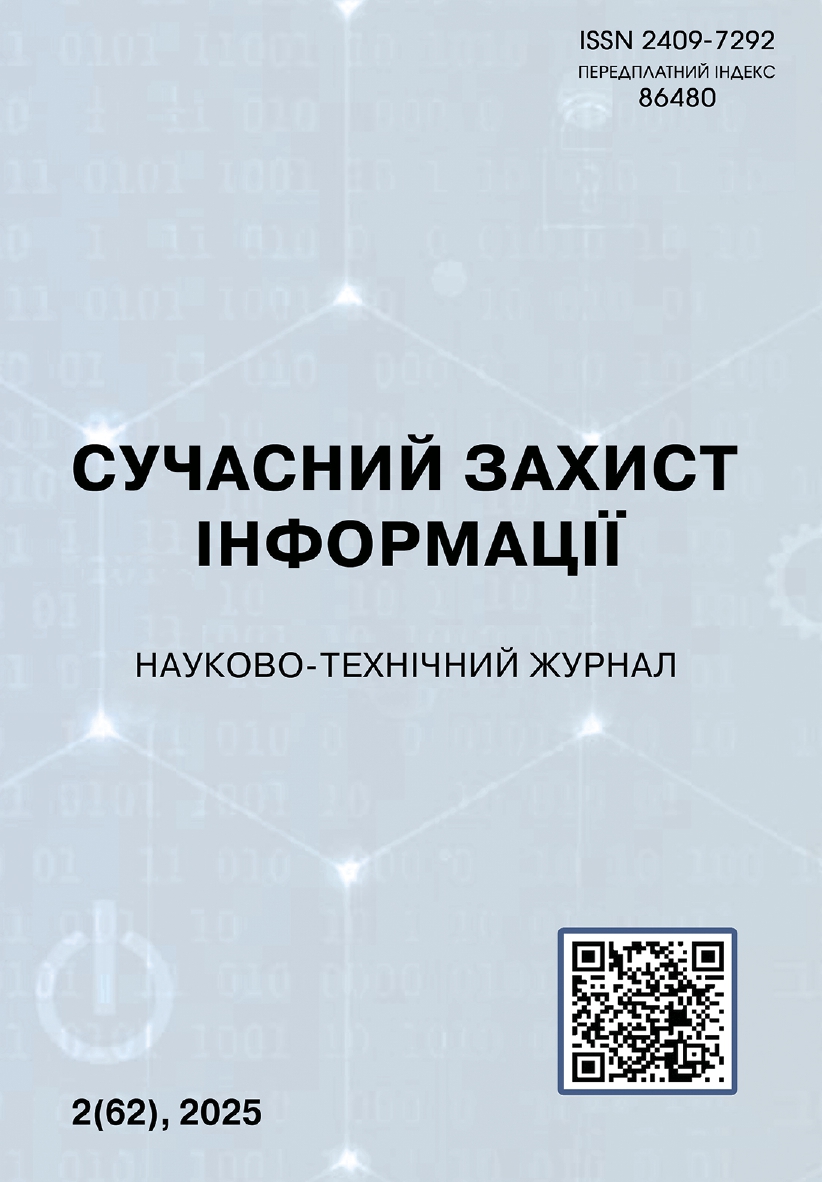ПРОБЛЕМИ КІБЕРБЕЗПЕКИ В ОРГАНІЗАЦІЯХ З ДИСТАНЦІЙНОЮ ФОРМОЮ ПРАЦІ
DOI: 10.31673/2409-7292.2025.020383
Анотація
Стрімке поширення віддаленої роботи у світі створює нові виклики для забезпечення ефективної та
безпечної цифрової взаємодії в організаціях. Метою даного дослідження є комплексний аналіз сучасних підходів,
інструментів та організаційно-правових засобів, що використовуються для організації захищеної цифрової
взаємодії в умовах віддаленої праці. Для досягнення поставленої мети застосовано метод аналізу літературних
джерел, який дозволив систематизувати інформацію про технологічні рішення, управлінські практики та
нормативні вимоги, пов’язані з віддаленою роботою.
Проаналізовано основні ключові аспекти: цифрові платформи та сервіси для комунікації й спільної роботи,
управління користувацькими пристроями та концепцію Bring Your Own Device (BYOD), а також правове
регулювання сфери кібербезпеки та приватності. За результатами дослідження встановлено, що використання
уніфікованих платформ для управління корпоративними сервісами зменшує фрагментацію цифрового
середовища та ризики витоку даних; надання співробітникам захищених корпоративних пристроїв або
запровадження чітких політик BYOD мінімізує основні кіберзагрози; дотримання міжнародних стандартів і
національного законодавства у сфері захисту інформації забезпечує правову відповідність діяльності
розподіленого колективу. Комплексний підхід, який поєднує сучасні технологічні інструменти, ефективне
управління та виконання правових норм, дозволяє підвищити рівень інформаційної безпеки та ефективності
дистанційної роботи, мінімізуючи потенційні ризики.
Ключові слова: кібербезпека, безпека хмарних технології, віддалена робота, BYOD, правове
регулювання.
Перелік посилань
1. Radha P., Sayyed N., Fathima Y. The new normal: navigating cyber security challenges in remote work policies.
NPRC journal of multidisciplinary research. 2024. Vol. 1, no. 8. P. 106–118. URL: https://doi.org/10.3126/
nprcjmr.v1i8.73042 (date of access: 30.04.2025).
2. Office I. L., Messenger J. C. Telework in the 21st century: an evolutionary perspective. International Labour
Organisation (ILO), 2019.
3. Sabin J. The future of security in a remote-work environment. Network security. 2021. Vol. 2021, no. 10. P.
15–17. URL: https://doi.org/10.1016/s1353-4858(21)00118-5 (date of access: 30.04.2025).
4. Rhodes C., Bettany A. Automating windows deployment with zero touch. Windows installation and update
troubleshooting. Berkeley, CA, 2016. P. 119–137. URL: https://doi.org/10.1007/978-1-4842-1827-3_5 (date of access:
30.04.2025).
5. AlShalaan M. R., Fati S. M. Enhancing organizational data security on employee-connected devices using
BYOD policy. Information. 2023. Vol. 14, no. 5. P. 275. URL: https://doi.org/10.3390/info14050275 (date of access:
30.04.2025).
6. Regulation (EU) 2016/679 of the European Parliament and of the Council of 27 April 2016 on the protection of
natural persons with regard to the processing of personal data and on the free movement of such data, and repealing
Directive 95/46/EC (GDPR). URL: https://eur-lex.europa.eu/eli/reg/2016/679/oj.
7. Jarrahi M. H., Reynolds R., Eshraghi A. Personal knowledge management and enactment of personal knowledge
infrastructures as shadow IT. Information and learning sciences. 2020. Ahead-of-print, ahead-of-print. URL:
https://doi.org/10.1108/ils-11-2019-0120 (date of access: 08.05.2025).
8. Bonderud D. Cost of a data breach 2024: Financial industry | IBM. IBM - United States. URL:
https://www.ibm.com/think/insights/cost-of-a-data-breach-2024-financial-industry (date of access: 07.05.2025).
9. Public Company Accounting Reform and Investor Protection Act of 2002, 15 U.S.C. § 7201 et seq. (2002).
https://www.govinfo.gov/content/pkg/PLAW-107publ204/pdf/PLAW-107publ204.pdf.
10. Nwankpa J. K., Datta P. M. Remote vigilance: the roles of cyber awareness and cybersecurity policies among
remote workers. Computers & security. 2023. P. 103266. URL: https://doi.org/10.1016/j.cose.2023.103266 (date of
access: 30.04.2025).
11. Das S., Dingman A., Camp L. Why Johnny doesn’t use two factor: A two-phase usability study of the FIDO
U2F security key. 2018. P. 160–179. URL: https://doi.org/10.1007/978-3-662-58387-6_9.
12. Repetto M. Adaptive monitoring, detection, and response for agile digital service chains. Computers &
Security. 2023. Vol. 132. P. 103343. URL: https://doi.org/10.1016/j.cose.2023.103343 (date of access: 08.05.2025).
13. Haag S., Eckhardt A., Schwarz A. The Acceptance of Justifications among Shadow IT Users and Nonusers –
An Empirical Analysis. Information & Management. 2019. Vol. 56, no. 5. P. 731–741. URL: https://doi.org/
10.1016/j.im.2018.11.006 (date of access: 08.05.2025).
14. Waelchli S., Walter Y. Reducing the risk of social engineering attacks using SOAR measures in a real world
environment: A case study. Computers & Security. 2024. P. 104137. URL: https://doi.org/10.1016/j.cose.2024.104137
(date of access: 09.05.2025).
15. Ratchford M., Wang P., Sbeit R. O. BYOD Security Risks and Mitigations. Advances in Intelligent Systems
and Computing. Cham, 2017. P. 193–197. URL: https://doi.org/10.1007/978-3-319-54978-1_27 (date of access:
09.05.2025).
16. Lim Y. Z., Rahman H. B. A., Sikdar B. False sense of security on protected wi-fi networks. Cryptography and
security. URL: https://arxiv.org/abs/2501.13363.
17. Al Jutail M., Al-Akhras M., Albesher A. Associated risks in mobile applications permissions. Journal of
Information Security. 2019. Vol. 10, no. 02. P. 69–90. URL: https://doi.org/10.4236/jis.2019.102004 (date of access:
09.05.2025).
18. Outdated software | OWASP foundation. OWASP Foundation, the Open Source Foundation for Application
Security | OWASP Foundation. URL: https://owasp.org/www-project-top-10-infrastructure-security-risks/docs/2024/
ISR01_2024-Outdated_Software (date of access: 09.05.2025).
19. Adascalitei D., Riso S. Effects of employee monitoring on remote work. An empirical study from Germany
and Spain using AMPWork survey data (2021-2022). Sinappsi. 2024. Vol. XIV. P. 93–112.
20. Bring your own device (BYOD): organizational control and justice perspectives / H. Lam et al. Employee
Responsibilities and Rights Journal. 2024. URL: https://doi.org/10.1007/s10672-024-09498-1 (date of access:
09.05.2025).
21. Regulation (EU) 2016/679 of the European Parliament and of the Council of 27 April 2016 on the protection
of natural persons with regard to the processing of personal data and on the free movement of such data, and repealing
Directive 95/46/EC (GDPR). URL: https://eur-lex.europa.eu/eli/reg/2016/679/oj.
22. J. G. Balancing employee privacy and cyber security in remote work: ethical and legal challenges. URL:
https://www.researchgate.net/publication/389711296_BALANCING_EMPLOYEE_PRIVACY_AND_CYBER_SECU
RITY_IN_REMOTE_WORK_ETHICAL_AND_LEGAL_CHALLENGES.
23. Swire P., Kennedy-Mayo D. The risks to cybersecurity from data localization – organizational effects. Arizona
law journal of emerging technologies. 2025. Vol. 8, no. 1. URL: https://doi.org/10.2458/azlawjet.7523 (date of access:
09.05.2025).
24. Golubock D. Remote workers, ever-present risk: employer liability for data breaches in the era of hybrid
workplaces. Journal of law, technology, & the internet. 2024. Vol. 15, no. 2. URL: https://scholarlycommons.
law.case.edu/jolti/vol15/iss2/4 (date of access: 09.05.2025).
25. Nwosu O. Monitoring productivity vis-a-vis employee privacy: legal and ethical considerations: thesis. 2022.
32 p. URL: https://doi.org/10.2139/ssrn.4095627 (date of access: 09.05.2025).
26. Simutina Y. Remote work in Ukraine: problems and prospects of improving its legal regulation. Yearly journal
of scientific articles “Pravova derzhava”. 2023. No. 34. P. 431–444. URL: https://doi.org/10.33663/1563-3349-2023-34-
431-444 (date of access: 09.05.2025).

